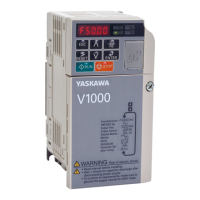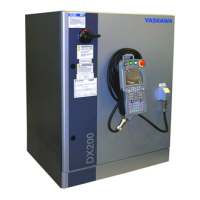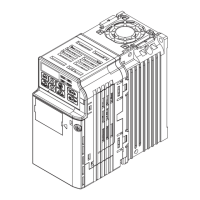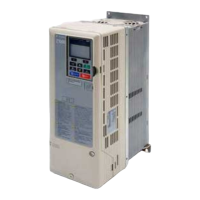6.9 Troubleshooting without Fault Display
YASKAWA ELECTRIC SIEP C710606 44B YASKAWA AC Drive T1000V Technical Manual 275
■ Drive Frequency Reference Differs from the Controller Frequency Reference Command
■ Poor Speed Control Accuracy
■ Deceleration Takes Longer Than Expected with Dynamic Braking Enabled
■ Motor Hunting Occurs When Operating With a Light Load
Cause Possible Solutions
The analog input frequency gain and bias are set to
incorrect values.
• Check the main speed frequency reference terminal input gain level assigned to terminals
A1 and A2, as well as the frequency reference input bias to terminals A1 and A2
(parameters H3-03, H3-04, and H3-12).
• Set these parameters to the appropriate values.
A frequency bias signal is being entered via analog
input terminals A1 or A2.
• If multi-function analog input terminals A1 and A2 are set for frequency reference (H3-02
= 0 and H3-10 = 0), the addition of both signals builds the frequency reference.
• Ensure that H3-02 and H3-10 are set appropriately.
• Check the input level set for terminals A1 and A2 (U1-13 or U1-14).
Cause Possible Solutions
Drive reached the slip compensation limit.
• Check the slip compensation limit (C3-03).
• Increase the value set to C3-03.
Motor-rated voltage is set too high in Open Loop
Vector Control.
• The input voltage for the drive determines the maximum output voltage. A drive with an
input of 200 Vac can only output a maximum of 200 Vac. Open Loop Vector Control
sometimes calculates an output voltage reference value that exceeds the maximum drive
output voltage level, resulting in a loss of speed control accuracy.
• Use a motor with a lower voltage rating (a vector control motor).
• Increase the input power voltage.
Auto-Tuning did not complete properly for Open
Loop Vector Control.
• Perform Auto-Tuning again.
Cause Possible Solutions
L3-04 is set incorrectly.
• Check the Stall Prevention Level during deceleration (L3-04).
• If a braking resistor option has been installed, disable Stall Prevention during deceleration
(L3-04 = “0”).
The deceleration time is set too long. Set deceleration to more appropriate time (C1-02, C1-04, C1-06, C1-08).
Insufficient motor torque.
• Assuming parameter settings are normal and that no overvoltage occurs when there is
insufficient torque, it is likely that the demand on the motor has exceeded the motor
capacity.
• Use a larger motor.
Reaching the torque limit.
• Check the settings for the torque limit (L7-01 through L7-04).
• If the torque limit is enabled, deceleration might take longer than expected because the
drive cannot output more torque than the limit setting. Ensure the torque limit is set to a
large enough value.
• Increase the torque limit setting.
• If multi-function analog input terminal A1 or A2 is set to torque limit (H3-02 or H3-10
equals 10, 11, 12, or 15), ensure that the analog input levels are set to the correct levels.
• Ensure H3-02 and H3-10 are set to the right levels.
• Ensure the analog input is set to the correct value.
Load exceeded the internal torque limit determined
by the drive rated current.
Switch to a larger capacity drive.
Cause Possible Solutions
Carrier frequency is too high. Lower the carrier frequency setting C6-02.
Large V/f setting value at low speeds triggers
overexcitation.
Use parameters E1-04 through E1-10 to set the V/f pattern in relation to the load
characteristics.
The maximum output frequency and the base
frequency reference are not set properly in
relationship to each other.
Set the proper values for the maximum output frequency and base frequency (E1-04 and E1-
06).
Hunting Prevention is disabled (V/f control only).
• Enable Hunting Prevention by setting n1-01 = “1”.
• (OLV only) Increase the speed feedback detection control gain and time constant (n2-01
and n2-02).
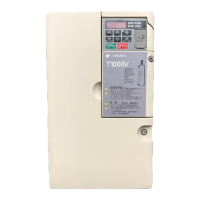
